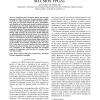Free Online Productivity Tools
i2Speak
i2Symbol
i2OCR
iTex2Img
iWeb2Print
iWeb2Shot
i2Type
iPdf2Split
iPdf2Merge
i2Bopomofo
i2Arabic
i2Style
i2Image
i2PDF
iLatex2Rtf
Sci2ools
JCP
2008
2008
Thermal Driven Placement for Island-style MTCMOS FPGAs
Rapid increase in transistor density and operating frequency has led to the increase in power densities, exhibiting itself as a high temperature profile. The high temperature spots over an FPGA impact the power, performance, and reliability of the chip, hence should be addressed during the design process. The logic block placement is targeted as the natural starting point to address the non-uniform thermal profile problem. The proposed placer simultaneously accounts for conventional placement objectives (routability and timing) while increases the temperature profile uniformity by optimizally spreading the power sources. As a measure of thermal uniformity in the simulation annealing core of the placer, a cost function is derived by adapting the concept of maximum entropy in a dual electrostatic charge model. The runtime complexity of this cost function is linear with respect to the number of used blocks, regardless of the size of the FPGA, and there is no need to perform the time-consu...
| Added | 13 Dec 2010 |
| Updated | 13 Dec 2010 |
| Type | Journal |
| Year | 2008 |
| Where | JCP |
| Authors | Javid Jaffari, Mohab Anis |
Comments (0)

